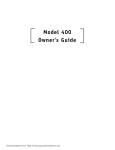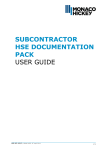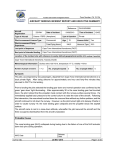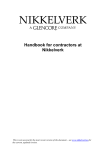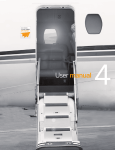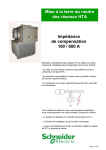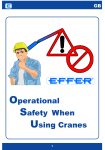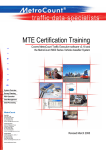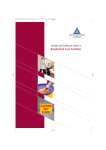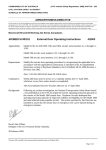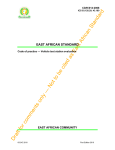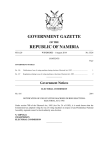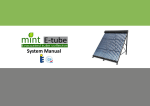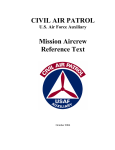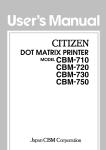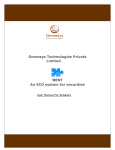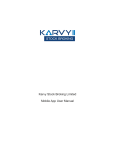Download as a proposed amendment of the Civil Aviation
Transcript
PROPOSED AMENDMENT OF THE CIVIL AVIATION REGULATIONS, 2011 Under regulation 11.03.2(6) of the Civil Aviation Regulations, the Chairperson of the Civil Aviation Regulations Committee (CARCom) hereby publishes for comment the proposed amendments to the Civil Aviation Regulations and Technical Standard, 2011, as set out in the schedules hereto. Any comments or representations on the proposed amendments should be lodged in writing with the Chairperson of CARCom, for attention Ms. Monica Sonjani or Mr. Herman Wildenboer, Private Bag 73 Halfway House, 1685, fax: (011) 545-1201, or e-mail at [email protected] or [email protected], before or on 5 January 2015. SCHEDULE 1 PROPOSAL FOR THE INSERTION OF PART 101 OF THE CIVIL AVIATION REGULATIONS PROPOSER SACAA Private Bag X73 Halfway house 1685 PROPOSER’S INTERESTS This proposer has been established in terms of the Civil Aviation Act, 2009 (Act No. 13 of 2009), to control and regulate civil aviation in South Africa and to oversee the functioning and development of the civil aviation industry, and, in particular, to control, regulate and promote civil aviation safety and security. MOTIVATION: This proposal is for the addition of a new Part to the regulations – the proposal is necessitated by the fact that there were no regulatory requirements for the operation of Remotely Piloted Aircraft Systems. Page 1 of 50 1. PROPOSAL FOR INSERTION OF PART 101 1.1 It is hereby proposed to insert the following Part in the Regulations: PART 101: REMOTELY PILOTED AIRCRAFT SYSTEMS List of regulations SUBPART 1: GENERAL PROVISIONS 101.01.1 Definitions 101.01.2 Abbreviations 101.01.3 Applicability 101.01.4 Private operations 101.01.5 Groupings and classifications 101.01.6 Directives 101.01.7 RPA sales and re-sales labelling SUBPART 2: APPROVAL AND REGISTRATION 101.02.1 RPA letter of approval 101.02.2 RPAS system safety 101.02.3 Altimeter 101.02.4 Registration and marking Page 2 of 50 SUBPART 3: PERSONNEL LICENSING 101.03.1 General 101.03.2 Requirements for the issue of an RPL 101.03.3 Theoretical knowledge examination 101.03.4 Flight training 101.03.5 Skill test 101.03.6 Revalidation check 101.03.7 Pilot logbook SUBPART 4: RPAS OPERATING CERTIFICATE 101.04.1 General requirements 101.04.2 Application 101.04.3 Validity 101.04.4 Duties of the holder of an ROC 101.04.5 Operations manual 101.04.6 Documentation and records 101.04.7 Security 101.04.8 Surveillance, safety and security audits and inspections 101.04.9 Register of operating certificates 101.04.10 Transferability 101.04.11 Liability insurance SUBPART 5: 101.05.1 Page 3 of 50 RPA OPERATIONS Weather conditions 101.05.2 Landing on roads 101.05.3 Controlled airspace 101.05.4 Releasing object or substance 101.05.5 Dangerous goods 101.05.6 Accidents and incidents 101.05.7 Consumption of alcohol and drugs 101.05.8 C2 operational requirements 101.05.9 Precautions and safety considerations 101.05.10 General restrictions 101.05.11 Beyond visual-line-of-sight 101.05.12 Night operations 101.05.13 Operations in the vicinity of people 101.05.14 Operations in the vicinity of property, structures and buildings 101.05.15 Operations in the vicinity of public roads 101.05.16 Radio communications requirements 101.05.17 Pre-flight preparation 101.05.18 Duties of pilot 101.05.19 Flight operations 101.05.20 Right of way 101.05.21 Use of time 101.05.22 Flight folio 101.05.23 Fuel, oil and charging records 101.05.24 First aid kits 101.05.25 Hand-held fire extinguishers Page 4 of 50 SUBPART 6: MAINTENANCE 101.06.1 Continued system maintenance 101.06.2 RPAS maintenance 101.06.3 Issuing of an RMT authorisation 101.06.4 RMT logbook SUBPART 1: GENERAL PROVISIONS Definitions 101.01.1 For the purposes of this Part, unless the context otherwise indicates, the following definitions shall apply – “autonomous unmanned aircraft” means an unmanned aircraft that does not allow intervention in the management of the flight; “autonomous operation” is an operation during which an unmanned aircraft is operating without intervention in the management of the flight; “background check” means the checking of a person’s identity and previous experience, including any criminal history as part of the assessment of an individual’s suitability to implement a security control and/or for unescorted access to a security restricted area; “beyond visual line-of-sight” means an operation in which the remote pilot cannot maintain direct unaided visual contact with the remotely piloted aircraft to manage its flight and to meet separation and collision avoidance responsibilities visually; “command and control link” means the data link between the remotely-piloted aircraft and the remote pilot station for the purposes of managing the flight; “communication link” means a digital or analogue data link to transfer voice or data between the remote crew, air traffic control, airspace users and other data users; Page 5 of 50 “corporate operation”, means a non-commercial operation or use of RPAS by an entity for professional or aerial work as an aid to the conduct of business of that entity; “down-link” means the direct or indirect communication link form the RPA; “extended visual line-of-sight” means an operation below 400 ft AGL in which an observer maintains direct and unaided visual contact with the remotely piloted aircraft at a distance not exceeding 1000 m from the pilot; “extended visual line-of-sight operation” means an operation below 400 ft AGL, in which an RPA observer assists in the direct unaided visual contact with the RPA, in order to facilitate separation and collision avoidance requirements; “model aircraft” means a non-human-carrying aircraft capable of sustained flight in the atmosphere and used exclusively for air display, recreational, sport or competition activity; “observer” means a trained and competent person designated by the operator who, by visual observation of the remotely piloted aircraft, assists the remote pilot in the safe conduct of the flight; “payload” includes all elements of an RPAS that are not necessary for flight but that are carried for the purpose of fulfilling specific mission objectives; “private operation” means the use of an RPA for an individual’s personal and private purposes where there is no commercial outcome, interest or gain; “radio line-of-sight” means a direct electronic point-to-point contact between a transmitter and receiver; Page 6 of 50 “remote pilot” means the person who manipulates the flight controls or manages the flight command instructions of a remotely-piloted aircraft during flight time; “remote pilot station” means the station at which the remote pilot manages the flight of the remotely piloted aircraft; “remotely piloted aircraft” means an unmanned aircraft which is piloted from a remote pilot station, excluding model aircraft and toy aircraft as defined in this Part; “remotely piloted aircraft system” means a set of configurable elements consisting of a remotely piloted aircraft, its associated remote pilot station(s), the required command and control links and any other system elements as may be required at any point during flight operation; “restricted visual line-of-sight” means an operation within 500 m of the RPA pilot and below the height of the highest obstacle within 300 m of the RPA, in which the remote pilot maintains direct unaided visual contact with the remotely piloted aircraft to manage its flight and meet separation and collision avoidance responsibilities; “toy aircraft” means a product designed or intended, whether or not exclusively, for use in play by children, and falling under the definition of aircraft.; “visual line-of-sight” means an operation below 400 ft AGL in which the remote pilot maintains direct and unaided visual contact with the remotely piloted aircraft at a distance not exceeding 500 m. Note: See pictorial view of VLOS and EVLOS in Document SA-CATS 101 Appendix A. Abbreviations 101.01.2 For the purpose of this Part, the following abbreviations shall apply – AGL means above ground level; Page 7 of 50 ATSU means Air Traffic Services Unit; C2 means command and control link; B-VLOS means beyond visual line of sight; CAMU means Central Airspace Management Unit; CAR means Civil Aviation Regulations E-VLOS means extended visual line of sight; FUA means Fair Use of Airspace; MTOM means maximum take-off mass; OpSpec means operational specifications; RLA means an RPA letter of approval; RLOS means radio line of sight; RMT means RPAS maintenance technician; ROC means RPAS operators certificate; RPA means remotely piloted aircraft; RPAS means remotely piloted aircraft system; RPL means a remote pilot licence; RPS means remote pilot station; R-VLOS means restricted visual line of sight; VLOS means visual line of sight. Applicability 101.01.3 (1) This Part applies to – Page 8 of 50 (a) class 1 and 2 of remotely piloted aircraft, unless otherwise approved by the Director; and (b) persons acting as owners, operators, observers, pilots and in the performance of maintenance of remotely piloted aircraft. (2) For the purposes of this Part, RPAS may be operated for the following purposes: (3) (a) commercial operations; (b) corporate operations; (c) non-profit operations; and (d) private operations. This Part does not apply to – (a) (b) (c) autonomous unmanned aircraft, unmanned free balloons and their operations or other types of aircraft which cannot be managed on a real-time basis during flight; an aircraft operated in terms of Part 94; and toy aircraft. Private operations 101.01.4 (1) Subject to sub-regulation (2), the provisions of Subparts 2, 3, 4 and 6 of this Part do not apply to private operation of RPAS. (2) Private operations of RPAS shall be conducted only in R-VLOS with a Class 1A or 1B RPA. Grouping and classification 101.01.5 RPAS shall be grouped in accordance with the classifications as prescribed in Document SA-CATS 101. Directives Page 9 of 50 101.01.6 The Director may, from time to time, issue directives which are necessary for safe and secure operation of RPAS. RPA sales or re-sales labelling 101.01.7 No RPA shall be sold within the Republic unless the seller has, by way of a packaging label, or in the case of the resale thereof, by way of written notification, notified the buyer of the requirements as imposed by the Civil Aviation Authority as prescribed in Document SA-CATS 101. SUBPART 2: APPROVAL AND REGISTRATION RPA letter of approval 101.02.1 (1) No RPA shall be operated within the Republic, unless such RPA has been issued with an RLA by the Director. (2) An application for the issuing or renewal of an RLA shall be made to the Director on the appropriate form and accompanied by the appropriate fee as prescribed in Part 187. (3) The Director shall issue an RLA if the applicant complies with the requirements prescribed in regulation 101.02.2. (4) An RLA shall be valid for a period of 12 months. RPAS system safety 101.02.2 (1) An applicant for the issue of an RLA, shall provide the Director with – Page 10 of 50 (a) documentation regarding the standard to which the RPA was designed; or (b) equivalent documentation that demonstrates a level of safety acceptable to the Director; or (c) documentation demonstrating system safety as prescribed in Document SA-CATS 101. Altimeter 101.02.3 (1) Except as provided in sub-regulation (2), an RPA shall be equipped with an altimetry system that is capable of displaying to the operator on the RPS, the height of the RPA above the surface. (2) An RPA that is not equipped with an altimetry system required by sub-regulation (1) shall be operated under R-VLOS only. Registration and marking 101.02.4 (1) No RPA shall be operated, unless such RPA holds a valid certificate of registration issued by the Director. (2) An RPA registered on the South African Civil Aircraft Register shall be deemed to have South African nationality. (3) An application for a certificate of registration shall be – (a) made on the prescribed form; and (b) accompanied by the fee prescribed in Part 187. (4) The Director shall register an RPA, issue a certificate of registration and a registration mark if the applicant complies with the requirements of this regulation. The Director shall maintain a register of all RPAs registered in terms of this regulation. Page 11 of 50 (5) The nationality mark format, size and location designated for use on RPAs shall be as prescribed in Document SA-CATS 101. (6) If the holder of a certificate of registration transfers to another person ownership of the RPA, such holder shall, within 30 days, notify the Director of such transfer on the appropriate form. SUBPART 3: PERSONNEL LICENSING General 101.03.1 (1) No person shall act as pilot of an RPA, except when undergoing a skill test or receiving flight instruction, unless he or she is in possession of a valid Remote Pilot Licence (RPL) in the relevant category. (2) (3) A Remote Pilot Licence may be issued for the following categories: (a) RPL (A): Aeroplane Remote Pilot Licence; (b) RPL (H): Helicopter Remote Pilot Licence; (c) RPL (MR): Multirotor Remote Pilot Licence. The following ratings may be endorsed on the licence: (a) VLOS: visual line of sight operations; (b) E-VLOS: extended visual line of sight operations; (c) B-VLOS: beyond visual line of sight operations; Requirements for the issue of an RPL 101.03.2 (1) An applicant for an RPL shall – (a) (b) Page 12 of 50 not be less than 18 years of age; (i) hold at least a valid Class 4 medical certificate for B-VLOS operations or operations involving RPAS classified as class 3 or higher; or (ii) (c) (d) (e) (f) (g) for all other classes or types of operation, submit a self-declared medical assessment report for operations involving RPAS classified as class 2 or lower: provided that an applicant who cannot meet the requirements of the medical assessment shall submit a Class 4 medical certificate. The report shall contain the information as prescribed in Document SA-CATS-101; hold a restricted Certificate of Proficiency in Radiotelephony (Aeronautical); provide proof of the ability to speak the English language at proficiency level 4 or higher, as prescribed in Part 61; where required, have completed the flight training referred to in this Subpart; have passed the theoretical knowledge examination referred to in this Subpart; and have passed the skill test referred to in this Subpart. (2) An application for an RPL must be made to the Director on the appropriate form within 30 days of completing the practical skill test. Theoretical knowledge examination 101.03.3 (1) The theoretical knowledge examination applicable to the category of licence sought must be passed within 90 days preceding the skill test. (2) The theoretical knowledge examination shall be conducted at an SACAA accredited test centre, except as provided for in sub-regulation (5). (3) The syllabi as well as other requirements for the examination shall be as prescribed in Document SA-CATS 101. (4) Approval shall be obtained from the Director before any foreign theoretical training or theoretical knowledge examination is undertaken if such training or knowledge is to be accredited towards a South African RPL. Flight training 101.03.4 (1) The flight training syllabi for the different categories of licence shall be as prescribed in Document SA CATS 101. (2) The organisation conducting the training shall issue a certificate stating that flight training has been successfully completed. Page 13 of 50 (3) All flight training shall be conducted with an aircraft of the same category for which the licence is sought. (4) Approval shall be obtained from the Director before any foreign flight training is undertaken if such training is to be accredited towards a South African RPL. Skill test 101.03.5 (1) The skill test for an RPL shall be conducted within 60 days of completing the flight training by an examiner accredited by the SACAA. (2) The skill test shall be conducted with an aircraft of the same category for which the licence is sought. (3) The holder of the RPL shall submit the skill test form to the SACAA within 30 days of the skill test. (4) The skill test shall include the applicable sections for the E-VLOS and B- VLOS ratings if one or more of these ratings is sought. Revalidation check 101.03.6 (1) An RPL is valid to the last day of the 24th month from the date of issue. (2) A revalidation check shall be conducted by an examiner accredited by the SACAA in the 90-day period before the expiry date of the validity period. The revalidation shall be valid from the expiry date for a period of 24 months. (3) The revalidation check shall be conducted with an aircraft of the same category for which the licence is held. (4) If a revalidation check is completed more than 90 days before expiry or within 36 months of the expiry of an RPL, the RPL shall be re-issued from the date of the check for the normal 24-month period. Page 14 of 50 (5) The holder of the RPL shall submit the revalidation check form to the SACAA within 30 days of the revalidation check. Pilot logbook 101.03.7 (1) The holder of a RPL must maintain in a pilot logbook a record of all his or her flight time, instrument time, simulation time and instruction time. (2) Where electronic logbooks are used, the electronic data must be printed on paper at least every 90 days and the printed pages filed sequentially in a binder. (3) The pilot must retain all pilot logbooks for at least 60 months from the date that person no longer holds a valid pilot licence. (4) The holder of an RPL must make the logbook available for inspection upon a reasonable request by an authorised officer, inspector or authorised person. SUBPART 4: RPAS OPERATOR CERTIFICATE General requirements 101.04.1 (1) No person shall operate an RPAS in terms of this Part unless such person is the holder of – (a) in the case of commercial, corporate and non-profit operations, a valid ROC including the operations specifications attached thereto; and (b) in the case of commercial operations, an air services licence issued in terms of the Air Services Licensing Act, 1990 (Act No. 115 of 1990). Application 101.04.2 (1) An application for the issuing of an ROC or renewal or an amendment thereto, shall be – (a) made to the Director on the appropriate form; (b) accompanied by – Page 15 of 50 (i) (ii) (iii) (iv) the appropriate fee as prescribed in Part 187; a copy of the certificate of registration of each RPA to be operated; a copy of the RLA for each device to be operated; and for an initial issue, an original Operations Manual prepared as prescribed in this Part. (2) No RPA shall be registered under more than one ROC. Validity 101.04.3 (1) An ROC shall be valid for 12 months unless – (a) it is surrendered by the holder thereof; or (b) it is suspended by an authorised officer, inspector or authorised person or cancelled by the Director. (2) The holder of an ROC shall, at least 60 days immediately preceding the date on which such certificate expires, apply for the renewal of such certificate. (3) The holder of an ROC which is cancelled shall, within seven days from the date on which the ROC is cancelled, surrender such document to the Director. Duties of the holder of an ROC 101.04.4 (1) The holder of an ROC shall – (2) (a) conduct the activities granted by such certificate and ensure compliance with the provisions authorised therein; (b) ensure compliance with any other requirements which the Director may impose; and (c) report to the Director any changes directly or indirectly related to the ROC that may affect continued validity of the certificate or approval or safety of persons and property. For operations approved for E-VLOS, the operator shall – (a) Page 16 of 50 make use of at least one observer who shall not be younger than 17 years of age; and (b) (3) ensure that each observer has completed the training prescribed by the operator and as approved by the Director in their operations manual. The holder of an ROC is accountable for the overall operation. Operations manual 101.04.5 (1) An ROC holder shall develop for approval by the Director, an operations manual containing all the information required to demonstrate how such operator will ensure compliance with the regulations and how safety standards will be applied and achieved during such operations. (2) An ROC holder shall set out the type and scope of operations, including the manner in which each type of RPAS and operation will be safely conducted. (3) The operations manual, or system of manuals, should reflect all operational and legislative activities and obligations which the ROC holder is obliged to meet, such that the content is commensurate with the size and scope of the operation. (4) The operator shall submit amendments to the Director for approval – (a) (b) (c) (d) prior to a change in any proposed aspect, type or scope of the operator's operation; where the operations manual no longer meets the requirements of these regulations or associated technical standards; on determining that any part or component thereof is, or becomes, inadequate; or as required by the Director. (5) Upon the approval of the operations manual amendments by the Director, the operator shall make such changes available to all persons engaged in the operation, deployment, handling, security, transportation and storage of any RPAS operated by such ROC holder and ensure that they are made aware, and where necessary trained in accordance with any relevant aspect relating to such amendment. Page 17 of 50 (6) The structure and contents of the operations manual shall be as prescribed in Document SA-CATS-101. Documentation and records 101.04.6 (1) An RPAS operator shall establish a system of record-keeping that allows adequate storage and reliable traceability of all activities developed, covering in particular: (a) lines of responsibility and accountability; (b) safety policy; (c) identification of aviation safety hazards encountered by the activities of the operator, assessment and mitigation of the associated risks, including taking actions and verifying their effectiveness (d) personnel training and competence (e) quality, safety and security management records. (2) The format of the records shall be specified in the ROC holder’s operations manual. (3) Records shall be stored for at least 5 years in a manner that ensures protection from damage, alteration and theft. Security 101.04.7 (1) The holder of an ROC issued under this Part shall – (a) conduct background checks on all personnel recruited for deployment, handling, transportation and storage of any RPAS; (b) conduct criminal record checks every 24 months on all personnel employed in the deployment, handling, and storage of RPAS; Page 18 of 50 (c) ensure that RPAS not in use are stored in a secure manner to prevent and detect unauthorised interference or use; (d) ensure that the RPAS is protected from acts of unlawful interference; (e) ensure that the RPA is stored and prepared for flight in a manner that will prevent and detect tampering and ensure the integrity of vital systems; (f) designate a security coordinator responsible for the implementation, application and supervision of the security controls; and (g) ensure that all personnel employed in the deployment, handling, and storage of RPAS have received security awareness training as prescribed in CAR Part 109. (2) The holder of a ROC shall include in the operations manual referred to in regulation 101.04.5 the security aspects of the RPA operations as prescribed in this regulation and Document SA-CATS 101. Surveillance, safety and security audits and inspections 101.04.8 (1) An applicant for the issuing of an ROC shall permit an authorised officer, inspector or authorised person to carry out such safety and security inspections, audits and oversight as may be necessary to verify the validity of any application made in terms of regulation 101.04.2. (2) The holder of an ROC issued in terms of regulation 101.04.2, shall permit a person authorized by the Director to carry out such safety and security inspections, audits and oversight, including safety or security inspections and audits of its partners or subcontractors, as may be necessary to determine continued compliance with the provisions of regulations and the privileges granted by the certificate. Register of operating certificates 101.04.9 The Director shall maintain a register of all certificates issued in terms of this subpart. Page 19 of 50 Transferability 101.04.10 An ROC issued in terms of this Part shall not be transferable. Insurance 101.04.11 An ROC holder shall at all times be adequately insured for third party liability. SUBPART 5: RPA OPERATIONS Weather conditions 101.05.1 No person shall operate an RPAS in weather conditions that do not allow unobstructed visual contact to be maintained with the RPA by other airspace users and by the operator unless in B-VLOS or night operations approved by the Director in their operations manual. Landing on roads 101.05.2 No person shall use a public road as a place of landing or take-off of an RPA, except when involved in civil defense or law-enforcement operations and provided that at all times reasonable care is taken to ensure the safety of persons and property on the ground. Controlled airspace 101.05.3 (1) No RPAS may be operated in controlled airspace, except by the holder of an ROC and as approved by the Director in the operators’ Operations Manual. (2) The Director may approve an RPA operation in controlled airspace as contemplated in sub-regulation (1) only in – (a) VMC in an ATZ and CTR below 400ft; and Page 20 of 50 (b) subject to compliance with the conditions prescribed in Document SACATS 101. Releasing object or substance 101.05.4 No object or substance shall be released, dispensed, dropped, delivered or deployed from an RPA except by the holder of an ROC and as approved by the Director in the operators’ Operations Manual. Dangerous goods 101.05.5 (1) Subject to sub-regulation (2), no RPA shall carry dangerous goods as cargo, except by the holder of an ROC and as approved by the Director in the operations manual. (2) The provisions of Part 92 apply, with the necessary changes, to the conveyance of dangerous goods by an RPA. Accidents and incidents 101.05.6 All accidents and incidents involving an RPA must be reported as prescribed in Part 12, where there is – (a) any injury to a person; (b) damage to property; or (c) destruction of the RPA beyond economical repair. Consumption of alcohol and drugs 101.05.7 No RPA pilot, observer or RMT shall – (a) consume alcohol less than 8 hours prior to reporting for duty; (b) commence a duty period while the concentration of alcohol in any specimen of blood taken from any part of his or her body is more than 0,02 grams per 100 millilitres; Page 21 of 50 (c) consume alcohol or any psychoactive substance during the duty period or whilst on standby for duty; or (d) commence duty period while under the influence of alcohol or any psychoactive substance having a narcotic effect. C2 operational requirements 101.05.8 An RPAS shall comply with C2 operational requirements as prescribed in Document SA-CATS 101. Precautions and safety considerations 101.05.9 (1) No person shall operate an RPAS unless – (a) the RPA is in a fit-to-fly condition; (b) the pilot is the holder of a licence issued in terms of this Part; (c) the remotely piloted aircraft station is compatible and interoperable with the aircraft it is connected to in all phases of flight; and (d) the RPA is being controlled by only one RPS at any given moment in time. (2) No person shall operate an RPA in a negligent or reckless manner so as to endanger the safety of any person, property or other aircraft in the air or on the ground. (3) The operator shall, in the best interest of safety, ensure that certain RPA operations are supplemented with additional personnel for non-flying duties, such that the RPA pilot can maintain control and situational awareness in respect to positioning and collision avoidance. General restrictions Page 22 of 50 101.05.10 (1) No person shall operate an RPA unless they have in their possession – (a) a valid RPA Pilot Licence; (b) a copy of the ROC and associated OpSpec; (c) the certificate of registration for each RPA in operation; (d) a copy of the RLA; and (e) user manual for the RPA and the remote pilot station. (2) No RPA shall – (a) tow another aircraft; (b) perform aerial or aerobatic displays; (c) be flown in formation or swarm; (d) be flown adjacent to or above a nuclear power plant, prison, police station, crime scene, court of law, national key point or strategic installation. (3) Except by the holder of an ROC, and as approved by the Director, no RPA shall be operated – (a) above 400 ft above the surface; (b) within a radius of 10 km from an aerodrome; and (b) within restricted or prohibited airspace. Beyond visual line-of-sight 101.05.11 (1) An RPA shall not be flown beyond visual-line-of-sight (B-VLOS) unless by the holder of an ROC and as approved by the Director in the operations manual. (2) The Director may approve B-VLOS operation subject to the operator meeting the requirements prescribed in Document SA-CATS 101. (3) Approved B-VLOS operations may only be conducted in VMC, below 400 ft above ground level, unless otherwise approved by the Director. Page 23 of 50 Night operations 101.05.12 (1) An RPA may not be flown at night except – (a) in R-VLOS operation; or (b) by the holder of an ROC, and as approved by the Director in terms of subregulation (2). (2) The holder of an ROC intending to operate an RPA at night, shall, as a minimum have each RPA approved under their ROC for night operations subject to compliance with the requirements prescribed in Documents SA-CATS 101. (3) An RPA may not be flown at night in controlled airspace except as approved by the Director as prescribed in regulation 101.05.3. Operations in the vicinity of people 101.05.13 No person shall operate an RPA directly overhead any person or group of people or within a lateral distance of 50 m from any person, unless – (a) the operator is the holder of an ROC and the operation has been approved by the Director in their operations manual; or (b) such person is the operator of the RPA or such person is under the direction of the operator of the RPA; or (c) such person or group of people forms part of the operations of the RPA, and is under control of the operator of the RPA, and adequate provisions have been made for their safety. Operations in the vicinity of property, structures and buildings Page 24 of 50 101.05.14 (1) No RPA shall be flown within a lateral distance of 50 m from any structure or building, unless – (a) the operator is a holder of an ROC and the operation has been approved by the Director in their operations manual; or (b) permission is obtained from the owner of such structure or building. (2) An operator conducting an operation as contemplated in sub-regulation (1) shall take such measures as are necessary to ensure the safety of all persons on the ground accessing such building or in the vicinity of such structure. Operations in the vicinity of public roads 101.05.15 No person shall operate an RPA over a public road, along the length of a public road or at a distance of less than 50 m from a public road unless – (a) such person is the holder of an ROC and the operation has been approved by the Director in the operator’s operations manual; or (b) in the case of operations over a public road, such road has been closed for public use; and (c) reasonable care has been taken to ensure the safety of road users and pedestrians in the event of loss of control of the RPA. Radio communication requirements 101.05.16 (1) Except for R-VLOS operations, no RPA shall be operated unless the RPA pilot has a functioning air-band radio in his possession, tuned to the frequency or frequencies applicable to the ATSU providing services or controlling such area or airspace or to aircraft in such area or airspace. (2) The air-band radio shall have the required output and be configured in such a way that the range, strength of transmission and quality of communication extends beyond the furthest likely position of the RPA from the RPA pilot. Page 25 of 50 (3) For VLOS, E-VLOS and B-VLOS operations, the RPA pilot shall, using the registration of the RPA as a call-sign, make the required radio calls, indicating the altitude, location and intended operation of the RPA in that area and at such intervals as are required in order to ensure adequate separation from other aircraft is maintained. (4) For approved RPA operations in controlled airspace, the RPA pilot shall maintain radio contact, using the registration of the RPA as a call-sign, with the relevant ATSU, and acknowledge and execute such instructions as the ATSU may give at any time during the operation of the RPA. Pre-flight preparation 101.05.17 An RPA pilot shall complete the pre-flight preparations prior to each flight, as prescribed in Document SA-CATS 101. Duties of pilot 101.05.18 (1) The pilot is accountable for safe operation of the RPAS. (2) The pilot of an RPA shall, on each flight, operate such aircraft in accordance with the manual, unless an unforeseen emergency dictates otherwise. (3) The pilot of an RPA is responsible for separation and avoidance of the RPA from other aircraft and any other obstacles and hazards. (4) The pilot of an RPA shall pilot such RPA in a manner so as to minimize hazards to persons and property on the ground, and other aircraft in the air. (5) The pilot shall ensure that at least one observer is used for E-VLOS operations. Flight operations Page 26 of 50 101.05.19 (1) The RPAS shall be operated in such a way that appropriate separation from other aircraft is maintained and that adequate obstacle clearance is ensured, during all phases of the flight. (2) The pilot of an RPA shall ensure that the take-off and landing area is safe and of the appropriate dimensions, free from obstacles and has adequate surface conditions, with regard to the type of operation, the size of the aircraft, the aircraft’s performance and external factors. Right of way 101.05.20 (1) An RPA shall give way to manned aircraft. (2) The RPA shall avoid passing over, under or in front of manned aircraft, unless it passes well clear and takes into account the effect of aircraft wake turbulence. (3) When two aircraft are approaching head-on or approximately so and there is danger of collision, each aircraft shall alter its heading to the right. (4) When two aircraft are converging at approximately the same level, the aircraft which has the other aircraft on its right, shall give way, (5) An aircraft which is being overtaken has the right-of-way, and the one overtaking shall alter its heading to keep well clear Use of time 101.05.21 (1) For the purposes of reporting and recording time, Co-ordinated Universal Time (UTC) shall be used and shall be expressed in hours and minutes and, when required, seconds of the 24-hour day beginning at midnight. (2) A time check shall be obtained from an air traffic services unit, if possible, prior to operating a controlled flight and at such other times during the flight as may be necessary. Page 27 of 50 (3) Wherever time is utilised in the application of data link communications, it shall be accurate to within 1 second of UTC. Flight folio 101.05.22 (1) The owner or operator of a South African registered RPA shall ensure that the RPA has a flight folio or any other similar document which meets the requirements of and contains the information as prescribed in Document SA-CATS 91, and the flight folio shall be accessible at the remote pilot station all times during flight. (2) The flight folio shall be kept up-to-date and maintained in a legible manner by the PIC. (3) All entries shall be made immediately upon completion of the occurrence to which they refer. (4) In the case of maintenance being undertaken on the aircraft, the entry shall be certified by the person taking responsibility for the maintenance performed. Fuel, oil and charging records 101.05.23 (1) The owner of operator shall maintain fuel or charging records to enable the Director to ascertain that, for each flight under his or her control, the requirements of sub-regulations (4) and (5) of this regulation are complied with. (2) The remote pilot of the aircraft shall enter the fuel, charging and oil records referred to in sub-regulation (1) in the flight folio. (3) The owner or operator shall maintain oil records to enable the Director to ascertain that trends for oil consumption are such that an aircraft has sufficient oil to complete each flight. (4) During VLOS operations, the remote pilot shall ensure that the aircraft has enough fuel or electrical charge to return to the point of landing, complete a landing and then fly for at least two minutes. (5) During B-VLOS operations, the remote pilot shall ensure that the aircraft has enough fuel or electrical charge to complete the intended flight plus a reserve of 20%. Page 28 of 50 First aid kits 101.05.24 (1) No owner or operator of an RPA shall operate the aircraft unless a first aid kit consisting of the medical supplies as prescribed in Document SA-CATS 91 for manned aircraft is available within the remote pilot station and within 300 m of the takeoff and landing points. A single kit may be used to comply with both these requirements. (2) The owner or operator shall carry out periodical inspections of the first aid kit to ensure that, as far as practicable, the contents thereof are in a condition necessary for their intended use. (3) The contents of the first aid kit shall be replenished at regular intervals, in accordance with instructions contained on their labels, or as circumstances require. (4) The first aid kit shall be readily accessible to all crew members involved in the operation. Hand-held fire extinguishers 101.05.25 No owner or operator of an RPA shall operate the RPA unless – (a) a hand-held fire extinguisher is available in the remote pilot station and within 300 m of the takeoff and landing points; (b) a hand-held fire extinguisher suitable for use with electronic equipment and any power generating equipment in use is available in the remote pilot station; and a hand-held fire extinguisher suitable for use on the RPA is available within 300 m of the takeoff and landing points. (c) SUBPART 6: MAINTENANCE Continued system maintenance 101.06.1 (1) An RPAS shall be compliant with the manufacturer’s instructions for continued equipment maintenance through actions or inspections. (2) The owner shall submit to the Director for approval, a maintenance programme for the RPAS. RPAS maintenance 101.06.2 (1) The maintenance on an RPA or any component thereof shall be carried out by the following persons: Page 29 of 50 (a) In respect of an RPA classified as a Class 3 and higher, the holder of a valid RMT authorization; or (b) In respect of an RPA classified as Class 2 and lower, the ROC holder: provided that the holder can demonstrate to the satisfaction of the Director, its ability to perform the required maintenance on the RPA. Issuing of an RMT authorisation 101.06.3 (1) An applicant for the issuing or renewal of an RMT authorisation shall – (a) (b) (c) (d) be not less than 18 years of age; and be a South African citizen or in possession of a valid permanent residence permit or valid temporary work permit with a letter of employment; and shall have successfully completed appropriate training, provided by – (i) an organisation approved by the competent authority in the country where the training organisation is located; (ii) training provided manufacturer; or (iii) a training facility approved by the Director; or by an approved original equipment demonstrate the ability to perform maintenance functions to the Director where no training for the particular RPA is offered or available. (2) An application for the issuing of an RMT authorisation shall be made to the Director in the appropriate form and accompanied by the appropriate fee as prescribed in Part 187. (3) The Director shall issue an RMT authorisation if the applicant complies with the requirements prescribed in sub-regulation (1). (4) The holder of an RMT authorization shall not exercise privileges other than the specific privileges for which the authorization is issued. (5) An RMT authorisation shall be valid for a period of 24 months. RMT logbook Page 30 of 50 101.06.4 (1) Any person responsible for maintenance of RPAS shall maintain a personal logbook and shall record therein all work carried out on an RPAS and its components. (2) The form of and information to be contained in a logbook referred to in subregulation (1), and the manner in which such logbook shall be maintained, are as prescribed in Document SA-CATS 101. (3) No alterations of a logbook shall be made once it is signed off by a designated person. SCHEDULE 2 PROPOSAL FOR THE INSERTION OF SA-CATS 101 ISSUED UNDER THE CIVIL AVIATION REGULATIONS PROPOSER SACAA Private Bag X73 Halfway house 1685 PROPOSER’S INTERESTS This proposer has been established in terms of the Civil Aviation Act, 2009 (Act No. 13 of 2009), to control and regulate civil aviation in South Africa and to oversee the functioning and development of the civil aviation industry, and, in particular, to control, regulate and promote civil aviation safety and security. MOTIVATION: This proposal is for the addition of a new Part to the SA-CATS– the proposal is necessitated by the fact that there were no regulatory requirements for the operation of Remotely Piloted Aircraft Systems. Page 31 of 50 LIST OF TECHNICAL STANDARDS: REMOTELY PILOTED AIRCRAFT SYSTEMS 101.01.5 GROUPING AND CLASSIFICATION 101.01.7 RPA SALE AND RE-SALE LABELLING 101.02.2 RPAS SYSTEM SAFETY 101.02.4 REGISTRATION AND MARKING 101.03.3 1. Allocation of marks 2. Identification plate 3. Display of marks 4. Location of marks 5. Specification of marks 6. Measurement of marks THEORETICAL KNOWLEDGE EXAMINATION 1. 2. 3. 4. 5. 6. 101.03.4 General Items applicable to the remote pilot general examination Items applicable to all remote pilot licences Items applicable to the Remote Pilot licences (Aeroplane) Items applicable to the helicopter remote pilot licences (RPL(H)) Items applicable to the Remote Pilot licence (Multirotor)(RPL(MR)) FLIGHT TRAINING 1. 2. 3. 4. 5. General Items applicable to all Remote Pilot licences Items applicable to the Remote Pilot licence (Aeroplane)(RPL(A)) Items applicable to the Remote Pilot licence (Helicopter)RPL(H)) Items applicable to the Remote Pilot licence (RPL(MR) 101.04.5 OPERATIONS MANUAL 101.05.3 CONTROLLED AIRSPACE Page 32 of 50 101.01.5 Class GROUPINGS AND CLASSIFICATIONS Table 1: RPAS Classification line-of-sight Kinetic energy* (kJ) Height (AGL)(ft) MTOM (kg) Class 1A R-VLOS/VLOS/EVLOS/ A h < 400 m < 1.5 Class 1B R-VLOS/VLOS/EVLOS/ Ek < 15 h < 400 m<7 Class 1C R-VLOS/VLOS/EVLOS/ 15 <Ek < 34 h < 400 m < 20 Class 2A VLOS Ek > 34 h < 400 m < 20 Class 2B Experimental/Research Class 3A RLOS Ek > 34 h < 400 m < 150 Class 3B VLOS Any h > 400 m < 150 Class 4A RLOS Any h > 400 m < 150 Class 4B Any Any Any m > 150 Reserved Reserved Reserved Reserved Class 5 Reserved - means to be defined in the future H - means height above the surface Ek= 1/2∗Mass ∗ (1.4vmax)2 101.01.7 Page 33 of 50 RPA SALES OR RE-SALES LABELLING On the sale or re-sale of any RPA, the seller must display and insert a notice, to notify the purchaser of the following information. Such notice should, as a minimum include the follows: “Note: The operation of Remotely Piloted Aircraft (RPA) is regulated in terms of the South African Civil Aviation Regulations. Operations as a hobbyist are subject to the terms of Part 94, whereas private use is restricted in terms of Regulation 101.01.4 of the Civil Aviation Regulations. For private use – (a) The RPAS may only be used for an individual’s personal and private purposes where there is no commercial outcome, interest or gain; (b) The RPA may only be operated over property for which the operator has ownership or permission; (c) The RPAS can only be used in Restricted Visual Line of Sight which means within 500m of the pilot, and never to exceed the height of the highest obstacle within 300m of the pilot, during which the pilot can maintain direct unaided visual contact with the device to manage its flight and collision avoidance; and (d) The pilot must observe all statutory requirements relating to liability, privacy and any other laws enforceable by any other authorities. For all other use – (a) the RPA must first be approved by the South African Civil Aviation Authority for use by way of an RPA Letter of Authority (RLA); (b) all RPAs must be registered by the South African Civil Aviation Authority prior to use; (c) an RPA may only be operated in terms of Part 101 of the South African Civil Aviation Regulations which includes specific requirements that the operator shall hold an RPA Pilot License; and (d) no RPA may be sold to any person under the age of 18. 101.02.2 RPAS SYSTEM SAFETY Page 34 of 50 (1) An application for an initial approval, where no certification exists from an ICAO Contracting state shall be accompanied by all of the following information that is available from the manufacturer: (a) The RPAS Operating Manual from the manufacturer; (b) A submission, prepared by the applicant outlining all of the following information to the extent known, or available: (i) For Class 1 and Class 2 operations, only sections 1 and 2 (ii) For Class 3, Class 4 and Class 5 all sections below: below; Section 1 – RPAS Information 1.1 1.2 1.3 1.4 1.5 1.6 RPAS type RPA structure RPA composition flight envelope capability RPA dimensions/measurements and mass together with drawings mass and balance information Section 2 - Performance Characteristics 2.1 2.2 2.3 2.4 2.5 2.6 2.7 2.8 maximum altitude maximum endurance maximum range Airspeed (take-off, cruise, landing, stall, maximum) maximum rate of climb maximum rate of descent maximum bank angle turn rate limits Section 3 – Performance Capabilities and Limitations 3.1 3.2 3.3 3.4 3.5 3.6 3.7 3.8 3.9 3.10 3.11 Page 35 of 50 RPA performance limitations due to environmental and meteorological conditions (wind, ice, humidity, temperature, precipitation, hail) required take-off and landing distances and/or areas power type propulsion system (such as engine/motor, fuel, electrical, hydraulic, pneumatic, gas, solar) flight control surfaces and actuators payloads (specific or generic) location of all air data sensors, antennas, radios, and navigation equipment with respect to segregation and redundancy autopilot (type, manufacturer, description of working method) navigation systems (description of the components, together with horizontal, vertical position and velocity accuracy) use of frequencies sensors and/or telemetry 3.12 3.13 3.14 3.15 flight recovery system remote pilot station ground support equipment surveillance equipment Section 4 – Emergencies & System Failures 4.1 At the minimum, the following emergency scenarios should be documented, with procedures for handling them: (a) (b) (c) (d) (e) (f) (g) (h) (i) (j) (k) (l) (m) loss of autopilot (fatal error) loss of flight control due to servo failure, if applicable loss of propulsion power loss of engine power (one engine out), if applicable low battery voltage, if applicable loss of navigation components (heading or altitude) loss of Global Navigation Satellite System loss of data link (radio control link failure) loss of remote pilot station (remote pilot station communication failure) loss of power of remote pilot station loss of remote pilot/RPA observer communication dealing with structural damage any other failure modes or scenarios other than those listed above that can endanger safe flight, shall be identified, described and managed in appropriate manner. Section 5 – Hazard Assessment An objective assessment of the RPAS’s potential hazard considerations, which should include: (a) Identification of RPAS functions (b) Systems that assist with the identification of failure conditions (c) Management and mitigations of the failure conditions (d) A list of alarms and methods for troubleshooting Section 6 – Fail-safe features Procedures to be followed by the remote pilot in case of malfunctions or failure. Information of flight termination features. 101.02.4 1. REGISTRATION AND MARKING Identification plate Page 36 of 50 (1) (2) Every South African-registered RPA must have affixed to it an identification plate (engraved, stamped or etched) with its nationality and registration marks. The identification plate must– (a) be made of fireproof material of suitable physical properties; (b) be affixed to the RPA in a prominent position; and (c) include the registration mark issued by the authority which appears on the RPA’s certificate of registration 2. Display of marks (1) The nationality and registration marks must be – (a) (b) (c) (d) (2) (3) RPA affixed to the RPA by an appropriate means so as to ensure that such marking will not become detached from the RPA in the event of an accident or destruction of the RPA; legible; displayed to the best possible advantage having regard to the construction or features of the RPA; and kept clean and visible at all times. The registration mark letters and hyphen must be printed/painted in Roman characters, in black on a yellow background. The height of the yellow background shall be at least 120% of the font height. The size of the registration mark must be commensurate to the size of the 3. Location of marks (1) The marks on a fixed wing RPA must appear – (a) (b) (2) on the bottom and top surface of each wing; and on both sides of the fuselage between the wings and tail surfaces, or on the upper halves of the vertical tail surfaces The marks on a single or multi-rotor RPA must appear – (a) For spherical RPA the marks must be proportional to the surface area in two places diametrically opposite one another. (b) For non-spherical RPA the marks must be proportional to the surface on each side. 4. Allocation and specification of marks (1) (2) The South African nationality marks are the capital letters ZS, ZT, and ZU. The nationality and registration marks must consist of capital letters in Roman characters without ornamentation. Page 37 of 50 (3) (4) (5) The width of each letter (except letter “I”) and the length of the hyphen must be two-thirds of the height of the letter – where possible. Each letter must be separated from the letter which immediately precedes or follows it by a space equal to one-third the height of the individual letters, the hyphen being regarded as a letter for this purpose. The lines forming the letters and hyphen must be solid and the thickness of those lines must be one-sixth of the height of the letter. 101.03.3 THEORETICAL KNOWLEDGE EXAMINATION 1. General (1) The subjects and items relevant to the different categories of licence (aeroplane, helicopter and multirotor) are specified below. (2) Rewrite after failure (a) (b) A candidate may not apply to rewrite an examination until he or she has received the official result notification. A candidate who has failed an examination conducted by the Authority for the issue of a flight crew licence or rating may not rewrite the examination: (i) in the case of a first or second failure, within a period of 7 calendar days; (ii) in the case of a third or subsequent failure, within a period of 2 calendar months; (iii) where a mark of less than 50% was achieved, within a period of 2 calendar months. (c) (3) If a mark of less than 50% is achieved in conjunction with a third or subsequent failure, the respective periods of 2 calendar months shall run concurrently. Re-mark after failure (a) (b) (c) (d) A candidate who fails an examination with a mark of 65% or above may, within 30 days from the date of notification of the examination results, apply in writing for a re-mark. The application shall be accompanied by the appropriate fee prescribed in Part 187. If the re-mark results in a pass of the examination concerned, the remarking fee will be refunded. A candidate may not rewrite any examination in respect of which a remark has been requested and for which he or she has not been notified of the official result. Failure to comply with this condition will result in the premature re-write being invalidated and the applicable examination fee forfeited. Page 38 of 50 (4) Remote pilot general examination (a) (b) (5) This examination must be passed before the first licence examination may be written. The examination is not required for any subsequent licence examinations. Licence examinations: (a) (b) (c) Remote Pilot Licence (Aeroplane). Remote Pilot Licence (Helicopter). Remote Pilot Licence (Multirotor). 2. Items applicable to the remote pilot general examination (1) Air law for remotely piloted aircraft (RPA) (a) (2) SACAR Part 101 and Document SA-CATS 101. Human factors (a) Vision (i) Empty field myopia (ii) Adaptation to darkness (iii) Autokinesis. (b) Stress management (i) Causes of stress (stressors). (3) Meteorology (a) (b) (c) (d) (e) (4) Factors affecting air density Fog and mist Wind and gusts Thunderstorms. Aviation weather reports. Navigation (a) (b) (c) Latitude and longitude Aeronautical chart information (VFR) GPS (i) Components of a GPS system as used on an RPA (5) Lighting for remotely piloted aircraft. 3. Items applicable to all remote pilot licences Page 39 of 50 (1) Construction and parts of the remotely piloted aircraft (RPA) (as applicable to the category of licence) (2) Forces acting on an aircraft (as applicable to the category of licence) (a) (b) (c) (d) (3) Weight Lift Drag Thrust Axes of an aircraft and motion about the axes (a) (b) (c) Lateral axis – pitch Longitudinal axis – roll Normal axis – yaw. (4) Control of motion about the axes (as applicable to the category of licence) (5) Propulsion systems (as applicable to the category of licence) (a) (b) (c) (d) (e) Electric motors (i) Brushed motors (ii) Brushless motors (iii) Motor ratings. Electronic speed controllers Petrol engines Fuel mixtures Propellers (i) Sizes (length and pitch). (6) Weight and balance (as applicable to the category of licence) (a) Dimensions and weight of aircraft (b) Arm, moment, reference datum, flight station, centre of gravity (c) Forward and aft limitations of CG. (7) Servo motors and servo actuators used in remotely piloted aircraft. (8) Radio control link (a) Radio control transmitter and receiver (i) (b) (9) Setup (as applicable to the category of licence). Frequencies used. Data link (C2 link) (a) Airborne receiver (b) Remote pilot station (i) Command and control functions (ii) Telemetry (iii) Detect and avoid uplink and downlink Page 40 of 50 (iv) First person view (FPV) (v) Mission planner software (vi) Position and obstacle mapping (vii) Waypoint navigation. (c) Frequencies used (d) Setup. (10) Wireless links general (a) (b) (c) (d) (11) Flight controller (autopilot system) (a) (b) (c) (d) (12) Line-of-sight (i) Fresnel zones Interference Coverage range Antennas as used in remotely piloted aircraft systems. Inputs and outputs Inertial measurement unit (IMU) Flight modes and facilities Setup. Batteries (a) (b) (c) (d) (e) (f) Sealed lead-acid (SLA) Nickel-cadmium (NiCad) Nickel-metal hydride (NiMH) Lithium-ion (Li-Ion) Lithium polymer (Li-Poly/LiPo) Charging of batteries. (13) The functions and required actions of the RPA observer. 4. Items applicable to the Remote Pilot Licence (Aeroplane) (RPL(A)) (1) The stall (a) (b) (c) Boundary layer Stalling angle of attack Aeroplane characteristics at the stall. 5. Items applicable to the helicopter remote pilot licence (RPL(H)) (1) Flight controls (a) (b) (d) (2) Collective control Cyclic control Anti-torque control. Main and tail rotors. Page 41 of 50 (3) (4) (5) (6) (7) (8) Swash plate. Rotor head. Rotor blade stall. Fly bar. Ground effect. Helicopter setup. 6. Items applicable to the Remote Pilot Licence (Multirotor) (RPL(MR)) (1) Different configurations and frames. 101.03.4 1. FLIGHT TRAINING General Flight training can be a combination of simulator and aircraft training. The exercises need not be done in the sequence given. 2. Items applicable to all Remote Pilot Licences (1) (2) (3) (4) (5) (6) (7) Aircraft preflight inspection and setup. Post-launch in-flight evaluation procedures (checking of systems directly after launch - if applicable to the category of licence). Automated flying and flight controller flight modes. First person view (FPV) flying (if applicable). Parachute-assisted landing (if applicable to the category of licence). Evasive action (maneuvers) to avoid collisions. Post-flight inspection. 3. Items applicable to the Remote Pilot Licence (Aeroplane) (RPL(A)) (1) (2) (3) (4) (5) (6) (7) (8) (9) (10) (11) (12) (13) Climbing and descending. Turns while maintaining altitude. Climbing and descending turns. Speed changes while maintaining altitude. Horizontal figure eight. Stalls. Recovery from a spin. Takeoffs. Catapult launch (if applicable). Hand launch (if applicable). Approaches and landings. Hand launching (if applicable). Engine failure (a) (b) (c) Page 42 of 50 At altitude After takeoff On the approach. 4. Items applicable to the Remote Pilot Licence (Helicopter) (RPL(H)) (1) (2) (3) (4) (5) (6) (7) (8) (9) (10) (11) (12) (13) Tail-in hover. Tail-in hover performing squares and circles. Takeoffs. Tail-in hover performing a horizontal figure eight. Tail-in hover performing a vertical rectangle. Side-on hover (both sides) Transition from hover to forward flight. Transition from forward flight to hover. Turns from level flight. Climbing and descending from level flight. Approach and landing. Nose-in hover. Autorotation. 5. Items applicable to the Remote Pilot Licence (RPL(MR)) (1) (2) (3) (4) (5) (6) (7) (8) (9) (10) Tail-in hover. Tail-in hover yawing slowly to right and left. Tail-in hover, move to right then to the left. Tail-in hover, move forwards then backwards. Tail-in hover, ascend and descend. Takeoffs. Tail-in hover performing a horizontal rectangle. Tail-in hover performing a vertical rectangle. Nose-in hover. From hover fly a square box rotating (yawing) the multirotor in the direction of flight. From hover fly a circle rotating (yawing) the multirotor nose-in to the centre of the circle. Transition from hover to forward flight. Climbing and descending from level flight. Turns from level flight. Speed control in level flight. Approach and landings. Actions after failure of a motor. (11) (12) (13) (14) (15) (16) (17) 101.04.5 OPERATIONS MANUAL Each ROC holder shall submit to the Director for approval, an Operations Manual (OM), the content of which is commensurate with the size and scope of their intended operations. The content of the OM shall be in the following format – Part A: (a) General Administration & control (i) Page 43 of 50 Company information, address and contact details (ii) (iii) (iv) (v) (vi) (vii) (b) Organization and operational control (i) (ii) (iii) (iv) (v) (vi) (vii) (viii) (ix) (x) (xii) (xiii) Part B: (a) Table of Contents of Manual List of effective pages to control the version and revision of such OM Revision number Distribution list Definitions and Acronyms Statement of Compliance Organizational structure including an Organogram; Organizational responsibilities of post holders and designated persons; Responsibilities of support personnel; Technical description of each RPAS for intended use by the ROC holder; Area or scope of operation; Operating limitations and considerations required by the Director; Operational Control Parameters; Accident prevention and safety programme; Flight crew qualifications and duties RPA Operations; Crew health Documents and Record keeping Operating Procedures Flight planning / preparation (i) (ii) Scope and feasibility Site location assessment considerations: (aa) (bb) (cc) (dd) (ee) (ff) (gg) (hh) (ii) (jj) (kk) airspace considerations conflicting aircraft or RPA traffic hazards identification local by-laws obstructions restrictions habitation and conflicting activities public access permission from landowner likely operating site and alternative sites weather conditions and planning (iii) Risk management - Identification of the hazards, risk assessment, mitigating procedures. (iv) Communication procedures; (v) Notification of intended operations to affected persons; Page 44 of 50 (b) (vi) Location and site permissions (vii) Weather considerations On site procedures & pre-flight checks (i) (ii) (iii) (iv) (v) (vi) (vii) (viii) (ix) (x) (c) Site visual survey; Selection of operating area; Crew briefing Cordoning off procedure (where applicable); Communication range and capability requirements; Weather observations; Re-fuelling or recharging; Loading of operational equipment; Preparation and assembly of RPA on site; Pre-flight and post flight checks Flight procedure (i) (ii) (iii) (iv) (v) (d) start take-off in flight landing shutdown Emergency procedure (i) (ii) (iii) (iv) (v) Part C: (a) Part D: Unique to the RPA to be operated; Fire - Risk and preventative measures; Accidents considerations and emergency response plan Loss of control link RPA - normal, abnormal and emergency procedures Training Details of the operator’s training programme Safety and Security An operator shall ensure that policy and procedures in respect of the following aspects of security are addressed in its Operations Manual: (a) RPAS operator organisation and designation of a security coordinator; (b) Requirements for checks and searches of specific areas and accessible compartments of the interior and exterior of RPAS; (c) Prevention of unauthorised access to remotely piloted aircraft and ground control stations; Page 45 of 50 (d) Protection efforts pertaining to limiting the software and C2 links from forms of interference; (e) Response procedures for crew members and other staff for threats and incidents; (f) Special procedures for crop spraying operations, the carrying of weapons, dangerous goods, high consequence dangerous goods and high value cargo, if applicable; (g) Crew member briefings concerning security/safety sensitive cargo loads; (h) Additional security measures for special or more threatening situations; (i) Reporting of security related incidents to the authority; (j) Details on procedures and frequency on conducting background checks and recurrent criminal record checks; and (k) Details on security awareness and response procedure training Part E: (Optional for smaller operators) (a) (b) SMS and Quality Assurance Programme. 101.05.3: (1) An RPA, intended for operations within an ATZ or CTR, shall as a minimum, meet the following technical requirements, which must be serviceable and functioning for the duration of such proposed operation, the failure to any one of which shall require that such operations are terminated: (a) (b) (c) (d) (2) CONTROLLED AIRSPACE Be fitted with a mode C or S transponder capable of displaying the unique squawk code issued to them, unless otherwise exempted by the Director and/or the applicable ATSU or CAMU according to an FUA application; Be fitted with an altimeter, capable of displaying to the operator on the RPS, the RPA’s altitude above mean sea level, corrected for ambient pressure (QNH); Be fitted with a functioning strobe light or lights, installed in such a way that such strobe lights are visible from both below and above the RPA; at all azimuth angles, and In the instance of a fixed-wing RPA, be fitted with navigation lights. An ROC holder, who intends operating in an ATZ or CTR, shall as a minimum, meet the following operational requirements: Page 46 of 50 (a) (b) (c) (d) (e) (f) Include in its Operational Manual, details pertaining to such RPA operations under the ROC, detailing how the safety and separation measures for aircraft operating in the ATZ or CTR will be achieved; Notify the relevant ATSU in advance of such operations, outlining the intended type and scope of operations; Receive confirmation from the ATSU that such operations can be accommodated, wherein such ATSU may outline any limitations, requirements or considerations pertinent to the RPA design capability or operational circumstances; Supply the ATSU with the intended RPA’s performance details including at least the type of RPA, speed, rate of climb and descent and abort or emergency landing procedure; Communicate, and have approved, or accept instructions pertaining to all movements of such RPA from the ATSU via air-band communications; Include a detailed response and reaction procedure, agreed by both the ROC holder and the relevant ATSU, in respect to the handling of any emergency, which as a minimum shall include: (i) (ii) (iii) 101.05.8: Aborting the RPA’s activity detailing the time to and expected landing place and capability; Loss of control, which shall include both a technical failure of the RPA and a link failure between the RPS and the RPA; and Procedures relating to a loss of communication between the ATSU/CAMU and the RPA Operator. C2 OPERATIONAL REQUIREMENTS (1) A prospective operator of an RPAS shall develop the C2 performance requirements safety case for approval of the Director. (2) The following C2 functions shall be considered for the safety case: (a) Downlink (i) (ii) (b) Telemetry (i) (ii) (iii) (c) RPA flight dynamics Situation awareness [for BVLOS operations] Data records Uplink (i) (ii) (iii) (iv) Page 47 of 50 Link health telemetry [for BVLOS operations] System health Flight Control RPA System control Automatic Identification System update [for BVLOS operations] RPAS hand over (v) (3) The RPAS operator shall present the target values of the C2 Performance requirements that were obtained from the safety case of the C2 functions to the Director. (a) (b) (c) (d) 101.05.11: 1. Link health telemetry [for BVLOS operations] Continuity Integrity Availability Latency of the C2 data link. BEYOND VISUAL-LINE-OF-SIGHT Outside controlled airspace An RPAS, intended for B-VLOS operations shall as a minimum, meet the following operational and technical requirements; (a) (b) The operator shall demonstrate compliance with the following technical requirements: (i) that the RPA will only be operated using command inputs; (ii) has met the requirements prescribed in Technical Standard-101.02.2; (iii) that the RPA has the ability to remain clear from obstacles and any other hazards and can take appropriate action to execute collision avoidance from such obstacles or other aircraft where necessary. This ability shall be applicable for normal and lost/degraded C2 links unless: (aa) The area is void of other air traffic; or (bb) The operation occurs in specifically delimited or segregated airspace; or (cc) Any other mitigation is in place to avoid other aircraft, obstacles or any hazards. (iv) the C2 datalink frequency to be used for data link is deemed appropriate by the Director; and (v) The C2 performance requirements as specified in Technical Standard 101.05.8 are acceptable to the Director; The operator shall demonstrate to the satisfaction of the Director the following operational capabilities prior to receiving approval for B-VLOS operations: (i) (ii) Page 48 of 50 Show how the intended RPA will perform all its flight tasks through control inputs whilst in flight, and that such device is not ordinarily required to be flown manually; Command the RPA to follow a predetermined course or group of waypoint inputs; (iii) Provide inputs to the RPA that in the event of needing to avoid any aircraft or other obstacle, the RPA pilot is able to interrupt or introduce commands or instructions to the RPA, such that the RPA can be interrupted from its set course and can safely fly an alternative course, or land, to avoid known traffic; How the exact position of the RPA is displayed to the pilot, in real-time, on a moving map, such that the RPA pilot will be able to make radio calls and report the position of such RPA to any aircraft in the vicinity or to an ATSU providing services or controlling such airspace; How it reacts in the event of receiving a flight position command that conflicts with obstacles or high ground. (iv) (v) 2. Inside controlled airspace B-VLOS operations in controlled airspace shall meet requirements of Technical Standards 101.05.3 and 101.05.10. 101.05.12: NIGHT OPERATIONS For operations at night, the holder of an ROC must demonstrate to the satisfaction of the Director, how in the instance of their RPAS: (a) (b) (c) they meet the requirements for B-VLOS operations below 400 feet; and have strobe lighting installed on the RPA; for fixed wing operations, have navigation lights or in the instance of a helicopter or multi-rotor RPA, have a beacon light installed; 101.05.17: (1) (2) (3) (4) (5) (6) (7) PRE-FLIGHT PREPARATION Every remote pilot shall verify the relevant notifications for his/her area of operation before take-off, and coordinate if necessary. Every remote pilot shall verify the NOTAM publication for his/her area of operation before take-off, and adapt the mission planning if necessary. The remote pilot shall take into account the meteorological information relevant for his/her area of operations. When planning a flight, the weather shall be assessed based on suitable documentation such as forecasts, current weather or other suitable information, to determine whether the planned flight can be carried out in accordance with the system’s technical and operational limitations. The weather in which flights are to take place shall be such that the system can be operated in a safe way in all phases of flight. Before a flight is carried out, the flight shall be planned and prepared using up-to-date aeronautical charts, to determine in which type of airspace the flight will be carried out. Before a flight is carried out, the flight shall be planned and prepared using information and documentation such as AIP, AIP Supplements and Notams, so that the flight can be carried out safely within the conditions specified in the ROC and according to the Operations Manual. Page 49 of 50 (8) (9) (10) (11) (12) The remote pilot shall have ensured before take-off hat the flight can be carried out in a safe way. The operator shall ensure that the system’s status is inspected before a flight is carried out. The remote pilot shall ensure that his/her physical and mental condition are such that the safety of the air traffic will not be endangered, failing which the remote pilot shall not start the flight. The remote pilot shall ensure that all required documents are available before starting the flight. Before every flight, the roles and duties of each crew member must be defined in writing. The remote pilot is responsible for the operation and safety of the aircraft and its payload, if applicable, and for the safety of all crew members. 101.06.5: RMT LOGBOOK The log book shall contain the following information as a minimum: (a) Full name (b) Identification number (c) Name of employer (d) Record of all technical courses attended (e) Date of maintenance (f) Type and make of RPA (e.g. multirotor) (g) Work carried out (inspection, repair, overhaul etc.) (h) Signature of Quality Assurance. Page 50 of 50



















































